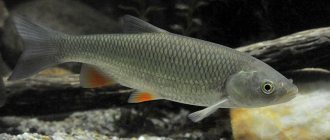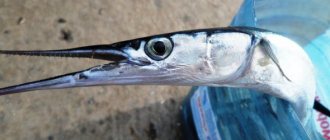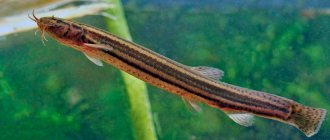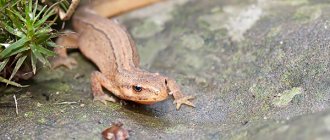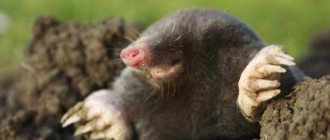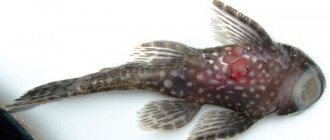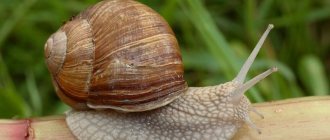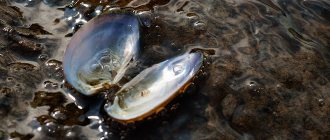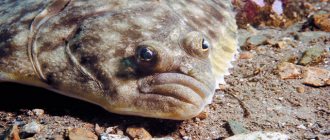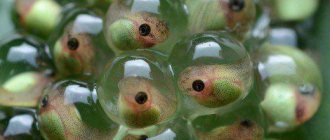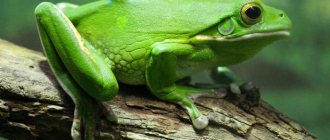Where it lives, what it looks like and description of the species:
Its habitat covers the territory from Central and Southern Siberia to Europe. In Europe, its habitats reach the south of the Pyrenees and the Alps; in Northern Scandinavia, Italy and Greece it is completely absent.
According to the IUCN Red List, this fish is native to the following countries:
Austria, Belarus, Belgium, Czech Republic, Denmark, Estonia, Finland, France, Germany, Italy, Kazakhstan, Latvia, Liechtenstein, Lithuania, Luxembourg, Moldova, Netherlands, Norway, Poland, Russian Federation, Slovakia, Sweden, Switzerland, Ukraine and UK .
Its habitat often coincides with the places where grayling and trout live, like them, it loves rivers with fast currents and rich oxygen content. One of the conditions for its residence is the presence of sandy - gravel soil at the bottom of the reservoir. It does not tolerate cold or warm water well (maximum 28 °C), and is rarely found above 650 m above sea level. Very demanding about the purity of water in the reservoir.
Very rare, but it can be found in small ponds and swamps or even in the coastal brackish water of the Baltic Sea. Can be found in large lakes provided they have access to fresh running water.
The gudgeon is a schooling river and bottom inhabitant of a reservoir; it always lives in a group, being at the bottom of the reservoir. Mainly nocturnal.
There is a subspecies of gudgeon that is found strictly in a limited area, this is the Dniester long-whiskered gudgeon (Gobio kessleri), found only in the Balkans and Eastern Europe, differs from the ordinary gudgeon by longer antennae and noticeable blue spots under or above the lateral line.
Photo of the common gudgeon, side view
Characteristic:
- Carp family, Pescari genus;
- Body size ranges from 8 to 15 cm, the largest recorded specimen was about 20.0 centimeters long and weighed 220 grams. But this is rather an exception, the normal length of his body is about 12.0 centimeters, the maximum body weight is 100 grams;
- The water temperature required for a comfortable life is from 17 to 22 ° C;
- Requires high oxygen content in water;
- The maximum age of life is about 5 – 8 years;
We recommend: What and how to catch burbot
It has a slender, almost round body, a flattened, blunt muzzle with large eyes. The mouth is located at the bottom of the mouth, and a pair of whiskers is located at the edge of the upper jaw.
The color of the back is from dark brown to olive, the ventral side is white, the sides are lighter with a longitudinal row of up to 11 dark, bluish shimmering spots. The dorsal, caudal and anal fins have many small dark spots
Along the lateral line, small flickering spots of irregular shape from bluish to violet are visible.
The scales are quite noticeably shaded by small colored pigments; the fish has a gray metallic sheen. Along the lateral line there are dark gray-blue spots, the fins are relatively transparent.
Photo: Minnow on the bottom, close-up
Features of fish
Of the features that directly concern the fisherman, it should be noted that, firstly
, the gudgeon is a schooling fish and its schools are very large (these are not 2-3 individuals, but tens and hundreds of fish),
and secondly
, the gudgeon is quite curious, it is a low-timid fish. In some cases, you can literally fish at your own feet if you go to a spit upstream. Some minnows will literally approach the fisherman. And even if you make a sudden movement and scare the fish, then after some time the gudgeon approaches again, especially if you create a cloud of turbidity around itself and throw in a worm.
Lifestyle
The common gudgeon lives in large schools and feeds on bottom-dwelling animals. In the spring, it rises from the wintering grounds from lakes to rivers to lay eggs in May or early June. In autumn it returns to the lakes.
These fish are usually active during the day, but after any encounter with a predator or danger, they may permanently stop going out during the daytime and become completely nocturnal.
Depending on activity level and temperature, and during the breeding season, minnows can make squeaking sounds.
Minnow spawning
The gudgeon becomes sexually mature when it reaches a length of at least 8 centimeters; the fish reaches this size in 2-3 years of life. During the year, the gudgeon spawns once.
In the spring, when the water warms up to +7 degrees, the gudgeon emerges from its winter torpor and mating games begin; a noisy event is accompanied by frequent water disturbances and splashes, creating a large population of gudgeons wishing to participate in reproduction. The place for spawning is chosen to be shallow with well-heated water.
At the end of April, beginning of May, the gudgeon spawning period begins, which can last until August. Fish reproduce at night, when the water warms up to +15 degrees.
Peculiarities of gudgeon spawning:
- The female spawns in shallow water, under stones and aquatic vegetation, but this does not happen all at once, but in portions; fertility ranges from 10 to 12 thousand sticky eggs.
- Small caviar with a diameter of slightly more than 1 mm, light blue in color, is released onto stones, snags, and soil.
- Minnows are not able to protect their offspring, so the eggs are masked with sand or silt.
- The eggs stuck to the bottom develop within 8 days.
- The hatched fry, due to the strong pigmentation of the eyes, are practically blind, react poorly to light, and therefore very often become easy prey for crayfish.
- In the first days, hatched larvae and fry eat bottom plankton and small invertebrates. In coastal waters, rich in various insects, the fry grow quickly.
- Juveniles stay in groups near the shore; as they grow, they move to deeper places.
What does it eat?
A special feature of the gudgeon is that it has a pair of antennae, with which it can feel the bottom and look for food. Its diet consists of small soil animals (worms, crustaceans, insect larvae). Rarely, it can eat the eggs of other fish and plant foods. Does not disdain carrion.
In the wild, it feeds mainly at the bottom, but when kept in captivity, it can be easily accustomed to feeding in different layers of water, the main condition being the absence of predators in the neighborhood.
In winter, unlike some other fish, it continues to actively feed.
Photo: Caught minnow
Method of catching gudgeon
Minnows are caught all year round; the bite begins at dawn and ends at dusk. The most convenient are light three-meter float fishing rods with thin fishing line; sometimes they fish with two hooks located one behind the other at a distance of 4-5 centimeters. The lightest float is used; the attachment is a motel or a worm. When fishing with float gear, the bait should drag along the bottom; the gudgeon rarely rushes after the bait; successful fishing will occur when the bait is located next to the gudgeon. Minnows are also attracted to slightly cloudy water from complementary foods or bottom sand.
In hot weather, when the gudgeon stays closer to the bottom, fishing with a jig will be productive.
Bottom gear is used after the spring ice drift. Long-cast donkeys, where the float is almost moved towards the rod with an enlarged sinker, are fished from the shore. An earthworm, bloodworm, or butterfly with clipped wings are attached to the hook as bait.
The gudgeon is very tenacious, so it is often used as bait for large aquatic predators. To determine the fishing spot for large fish, experienced fishermen first look for places where gudgeons are actively biting. Having identified such a place, you can be sure that large predators are scurrying around somewhere nearby.
Fishing:
Almost no one is intentionally fishing for gudgeon, except for some connoisseurs of its meat, which has good taste. For fishermen, the common gudgeon is valuable as live bait for catching pike, pike perch, perch, trout and other predatory fish.
It can be caught both in winter and summer. In winter, you should look for it on lakes that are adjacent to streams, rivers and there is current and oxygen in the water. In summer it can be found in clear rivers and streams with a current and a sandy and gravel bottom.
To catch it, use the following gear: a float rod and small nets - lifts if they are allowed in the fishing areas. It is usually caught in September - October, but you can catch it at any other time.
We recommend: Burbot, where it lives, when to catch it, behavioral characteristics
Distribution and habitats
Distributed in Europe (except Italy, Norway and Scotland), Central Asia, Western Siberia to the river. Yenisei, in the river basin Amur and China.
Minnow distribution map
It lives in large and small rivers, even in flowing lakes in the presence of sandy or sandy-pebble soils and clean water, but avoids too fast rivers and streams with cold water. In lakes it adheres to sandy shallows, as well as sandy and rocky shores, which are not too densely overgrown with underwater vegetation. In rivers during spring and summer, minnows stay on the riffles. With the onset of cold weather, they migrate to deeper places with sandy soil, and for the winter they lie down in holes, from where they emerge only in the spring.
It has no commercial significance. Can be used as a small fish for keeping in an aquarium. In its natural environment it is a food source for predatory fish, as well as a target for recreational fishing.
Reproduction
During the spawning season, this fish often makes short migrations upstream.
During the mating season, minnows communicate with each other and make clearly audible squeaking sounds. Males develop a pinpoint white spawning rash near the head. They become darker in color.
They spawn at night from May to June when the water temperature is around 18 degrees Celsius. A female can lay up to 3,000 eggs per spawning season. Small sticky eggs (size 1.3 - 1.6 mm) are laid in shallow water and sink to the bottom, where they stick to rocks or plants. They do not care or protect their eggs.
Depending on the water temperature, the larvae hatch in 10-30 days. When the yolk sac is used up, the juveniles begin to look for food at the bottom of the reservoir. She prefers weak currents on sandy soils rich in food. They grow very quickly and by the first winter they reach a body length of 5 cm.
At the age of 1-3 years they reach sexual maturity.
Life expectancy is usually 4 to 5 years (maximum 8 years), this age being greatly influenced by the temperature of the surrounding water.
Photo of a minnow in an aquarium
Leonid Pavlovich Sabaneev
Rice. 36. Blue minnow
It is, however, not found in Finland, with the exception of the southern parts of Vyborg province; in Lakes Ladoga and Onega, the gudgeon is rare and is found only in the southern parts of these basins, but further to the east it was found by Danilevsky near Arkhangelsk, also in Mezen and Peza, and in later times (by Petrov) - in Vytegra and Onega. Judging by the abundance of minnows in the rivers of the Bogoslovsky district, these locations have a high probability of occurrence. In any case, the gudgeon does not belong to the indigenous inhabitants of the rivers of the White and Arctic Seas and probably spread here in later times. In Pallas’s “Zoogeography”, only European Russia is named as the location of the gudgeon, but it is found in most of Western Siberia, as it is found in the Irtysh and in the Ob (lower reaches), as well as in the Yenisei. In addition, the gudgeon (a special variety of it) is found in the Turkestan region (in the Syr Darya and its tributaries). The real gudgeon was found only in the upper reaches of the Amu Darya (in the Dayravata River) at an altitude of 2000 feet. Note that, according to some information, this fish is very rare in the tributaries of the Don. In the lower reaches of the Volga and Urals it is quite numerous, and is also very common in the rivers of the Crimean Peninsula. In Kuma and Kura only long-whiskered gudgeon was found, in the river. Tuapse is ordinary.
Let's move on to the gudgeon's lifestyle. It lives both in large rivers and in the smallest rivers, is less common in flowing lakes and ponds[4], and even more so in winter, but, being transplanted into stagnant but clean water or getting there by accident, it multiplies there very quickly , although it never reaches the same magnitude as in rivers. In some exceptional cases, the gudgeon, according to Haeckel, is seen not only in swamps and underground waters (for example, in the Adelsberg grotto), but even in warm springs, such as those near Teplitz, Carlsbad, Baden, etc. In general, he loves clean water and fresh, although avoids very cold and too fast. Usually, throughout the spring and summer, minnows stay on or near rifts, in shallow places with a gristly or sandy bottom, which is where its main name with its many variants comes from. At the end of summer and autumn, minnows are seen in deeper places, also with a sandy or silty-sandy bottom, and are most often found near the very rifts, in small bays, where a small whirlpool is formed. They are never found in grassy places during the day, and in general gudgeons are found in the community of minnows and loaches. In October or November, depending on the area, gudgeons almost disappear and go to spend the winter in ponds or lakes, or hide in the deepest river holes, and since in winter they very rarely fall into seines, it is very possible that they sometimes burrow into the silt.
The gudgeon leads a completely diurnal lifestyle and never swims at night, but then lies motionless on the bottom, resting its pectoral, ventral and anal fins, as if on supports. In the midday heat, it sometimes, also for whole hours, stands in one place, leaning against a stone or snag, and this immobility of the gudgeon, together with its slab-like body, gave rise to the apt name of it by the Little Russians - column, column. In general, this small fish is not very lively, although it swims very quickly and can hold on for a very long time and even swim against a fast current. However, on the rifts the gudgeon hides behind the stones, and here it rises upward in pushes from one protection to another.
Due to the preference given to riffles, the river gudgeon, before all other fish, dies from water spoilage by any harmful substances: gas production residues, poisonous paints and other industrial waste. In Moscow itself, minnows also sleep in the summer when it’s hot, after rain, because they can’t stand the warm and smelly water from the hot pavement. Apparently, the long-whiskered gudgeon prefers quieter, deeper and sandy places, while the common gudgeon (in the warm season) stays exclusively on gristly or rocky bottoms. This explains why its belly often has bloody abrasions, especially during spawning. In general, the blue minnow is much weaker and less numerous than the black minnow and has never yet been found in lakes and ponds, and it seems to be very rare in streams and small rivers. Lake minnows, according to my observations in the lake. White and Tolstoy ponds, which have fairly cold water, stay (in summer) near the shores, on the sands; according to Terletsky, they, however, go into the depths for the summer, to the muddy bottom, and do not go to the shallows, which can be explained by the heating of the water near the shores.
The lake gudgeon, at least at night, stands in the depths and is unlikely to hide in the grass, like the river gudgeon. The latter, even before sunset, becomes clogged with algae and other aquatic plants growing on or near the rifts. Here the gudgeon is completely safe from predatory fish, especially burbot, which does not give it rest at night. In convenient places, experienced fishermen catch a lot of minnows at this time along with loaches and especially spiny loaches with a basket, or simply feel them with their hands and pull them out along with filamentous algae, in which all this little stuff gets entangled.
As was said, the gudgeon always stays at the very bottom, like a ruff, and extremely rarely rises to the surface of the water, even in fairly shallow places. However, on riffles, the gudgeon sometimes even jumps out of the water completely - upright, in a rather characteristic way, so that such a playing black fish is not difficult to distinguish from other small fish. This jumping out is noticed from time to time throughout the summer. According to some fishermen, minnows jump before spawning - they break eggs; others think that jumping out heralds a change in weather. Minnows, pursued in the shallows by predatory fish, also jump out of the water. In large and medium-sized rivers they are most persecuted by shereshpers, who prefer gudgeon to any other fish. Probably everyone has seen how a shereshper strikes on shallows and rifts. You can be sure that he swam unnoticed to a school of minnows, crashed into it and hit it with the aim of stunning some fish and picking it up. It should be noted that minnows live very amicably among themselves and are often found in flocks of mixed ages - last year's ones with old ones.
Like a bottom fish, the gudgeon always looks for food at the bottom. It usually feeds on small worms, insects, crustaceans, such as cyclops and daphnia, as well as particles of rotten organic matter, which it obtains from sand or silt. In this case, the antennae probably do the gudgeon a great service. In the mud, he gets himself bloodworms, which at the end of summer seem to be almost the main food of this fish, of course, where there are a lot of bloodworms. I even believe that the gudgeon’s retreat into the depths is determined not so much by the freshness of the water as by the abundance of red larvae of the pusher mosquito. The main food of the gudgeon in the spring seems to be the eggs of other fish, which cause significant harm. In addition to the fact that they intercept those swimming past on the rifts, b. including unfertilized eggs, gudgeons in April and partly in May feed on eggs swept by other fish on the rifts and stones, tearing off the stuck eggs with their thick lips. According to many authors, minnows also eat animal waste, even carrion: Marsigli enthusiastically tells how during the siege of Vienna by the Turks, minnows gave particular preference to the meat of infidels. Nevertheless, the gudgeon is less omnivorous than the barbel myron and consumes mainly animal food, which is proven by the practice of angler fishermen.
The spawning of minnows is in many respects still unexplored and presents many dark sides, requiring more detailed and accurate observations. We don’t even know anything about the spawning of blue bream, and we can only assume that it is unlikely to present any significant differences. The river blackfish apparently begins to rub about a month after it emerges from the deep places where it spent the winter. The hollow water finds him already near the shallow banks, where the current is quieter; then, soon, as soon as the river enters the banks, it takes its summer places, i.e., riffles, and begins to spawn. It seems that in large rivers, e.g. Volga, Oka and others, most of the gudgeon, due to their late flooding, enter small tributaries - rivers and streams - to spawn; in the Lower Volga, however, according to fishermen, minnows, due to the lack of convenient places, release eggs in crayfish burrows. In flowing lakes and ponds, minnows also go to rivers and streams to spawn.
Here, in Central Russia, gudgeons begin to spawn almost simultaneously with roaches - at the end of April or early May, but there is no doubt that spawning lasts a very long time, almost all of May and even June, and that the eggs , therefore, is released in parts, in several stages, and not all at once. It seems to me that this frequency of spawning can be explained by the relatively small number of males compared to females. While in most fish the number of milkfishes significantly exceeds the number of eggs, in gudgeons it is the opposite - there are very few males. They differ from females by their smaller stature, and during spawning by a granular rash on the head, back and upper side of the pectoral fins. According to Blanchard, there seem to be 5-6 times fewer of them than females. Therefore, we can give some credence to the observation that during spawning the female and male actually rub belly to belly, simultaneously releasing eggs and milt. Aquarium enthusiasts - indoor fish keepers - on the other hand, know very well that in order to fertilize the eggs there is no need for them to be directly doused with milk. In stagnant and quietly flowing water, eggs, according to theory, should be fertilized entirely, almost without residue, and the faster the flow, the more milk, obviously, is required for fertilization.
Be that as it may, the gudgeon spawns in rivers and streams in a very noisy manner and in numerous schools - in very small places, on cartilage and small stones. At the same time, the minnows stick out their tail and most of the body, except for the head and part of the belly, and hit the water with their tail. In medium rivers, gudgeon spawning is less noticeable: in dammed rivers, for example. in the Moscow River, due to the lack of riffles, it rubs mainly under the locks, under which it has been holding in masses since the end of April, attracting many pikes and shereshper. Here it spawns between the slabs and large stones that line the river bottom under the sluice. In large rivers, as has been said, gudgeons release eggs to extremes (in pairs?) even into crustacean burrows. In stagnant cold lakes, for example in the above-mentioned Beloye, which is near the village. Kosina, near Moscow, minnows, according to the information I collected from the tenant of the lake, rub on the sand, in small places near the very shore and gather here in such numbers that the water seems to be boiling. In the middle of summer, a curious phenomenon is noticed here, also probably related to spawning: the gudgeon suddenly begins to gather in fairly deep places in a continuous mass, forming a regular cone, the top of which is on the surface. The quantity of fish can be judged by the fact that if they catch this pile with a seine in a timely manner, they immediately pull out up to 10 pounds or more. It is very likely that minnows finish spawning in this way, since the highly heated water off the coast forces them to move to depths.
Minnow caviar, very small and bluish in color, is released onto stones, cartilage, less often driftwood and, in exceptional cases, onto grass. Here it sticks tightly, sometimes covering the bottom with a continuous layer. Most of the eggs, however, are the prey of the same minnows, which also destroy a great many of the newly hatched juveniles. The flood after spawning has a huge impact on the gudgeon harvest, since almost all the eggs and almost all the fry are carried away by the current. But under ordinary conditions, the fry manage to leave the rifts for quieter, albeit shallow places, namely, shallow sandy or, more often, sandy-muddy shores, where they remain throughout the summer, until mid-August and later, feeding exclusively on daphnia. cyclops and other small animal organisms that they find in the mud. It is very possible that juvenile gudgeons also feed on rotting substances in the early period of their lives. Small minnows crowd around the shore in clouds, choosing the smallest places, constantly poking their noses into the shore. They grow with amazing speed, comparatively faster than all other fish. According to my observations in the Moscow River (in 1889), the juvenile gudgeon at the end of July was already almost an inch tall (from the head to the end of the tail), and by the end of August it reached more than l½ century. Last year, 1890, which was distinguished by an unusually early spring, early spawning and, due to the warm summer, an abundance of food, gudgeons grew even faster.
In ponds and lakes, minnows never grow as large as in rivers. Large gudgeons are found both in small rivers (for example, in the Setun River near Moscow) and in large rivers. I met the largest minnows in the Volga, near Yaroslavl: they were more than 5 inches long and up to 2 inches thick. In the Moscow River in August and September, mainly three-inch, fifteen-month-old gudgeon are caught; gudgeon per quarter - this is for the 3rd year. It seems that minnows spawn only when they are almost 2 years old. A five-year-old gudgeon is, presumably, very rare: in the Moscow River, where it is exposed to great accidents, it is unlikely to reach such a respectable age. As for the blue minnow, it grows comparatively very slowly, and one and a half years old is never longer than 1/2 inch. It should be noted that by autumn, juvenile minnows of both species of different sizes are found, which is explained by the duration of their spawning.
Due to its size and location, the gudgeon obviously cannot have the slightest commercial significance. It is caught with gear only in small rivers for lack of larger fish and only for oneself, and not for sale, since the market value of the gudgeon is insignificant, with the exception, however, of the capital and large cities, where the gudgeon is sold quite expensively, but in very small quantities , since it has incomparably fewer consumers than the ruffe, and is delivered to live fish cages in small numbers. Where there is a lot of gudgeon, it is caught in the summer or in the fall with nonsense and duds from the rarest canvas. In spring, in hollow water, in some places it comes across marks; later, during spawning, they are crowded in masses into frequent tops, if the place for them has been successfully chosen. For hunter-fishermen, the opportunity to get gudgeon, which is the best river bait for all predatory fish, is of no small importance, and therefore, in addition to the mentioned methods of fishing, it is necessary to point out others, although more convenient, but almost unknown to us.
In Western Europe, especially in France, where the gudgeon enjoys great respect, much more than in our country the ruffe and even the burbot, these methods, very simple and handy, are very common. Firstly, a lot of gudgeons are caught here with special small and frequent small capes, which are thrown from a boat or a deep bank, after first stirring up the water with a pole or oar. But our game is not worth the candle. This fishing is difficult, and it is unlikely that anyone in Russia will catch such a small thing this way.
It is much easier to fish with a lifting net, which is rather little known among us. This, one might say, is a special projectile for catching minnows. The latter is often caught in this net by the hundreds at a time; but these so-called carrelets are also very suitable for catching all kinds of smallmouths in general, and especially leucaspius, although with modified techniques (see “Verkhovka”) On the Vistula, as far as is known, in such lifting nets, but of larger sizes and all sorts of large fish are caught in the muddy water. To catch a gudgeon, a thin net of strong threads 2 arshins square is sufficient; this net is strung on a strong twine, so that it also has the shape of a square, then two strong and smooth sticks are tied crosswise to the corners (walnut, birch) 2½ arches long; at the point of intersection these sticks are tightly tied. In this way, a shallow net bag is obtained, stretched by cross-linked sticks. If now a more or less heavy lead sinker is tied to the center of the net so that the net sinks to the bottom , then, obviously, if you quickly lift it by the rope, the sticks should bend and the net forms a more or less deep bag, from which very few minnows and ruffs manage to jump out, like fish crawling along the bottom and reluctantly rising to the top. The entire success of catching gudgeon with a lifting net is based on this. Only usually a net, or, more precisely, sticks, in the place where they intersect, is tied to the thin end of a more or less thick and long stake, up to 3-5 arshins, the kind used for basting. The heavier the free thick end of the pole, the easier and faster the wet net will rise from the water.
They are caught on the rise - from locks, bridges, especially floating ones, gangways and rafts, less often by wading and from boats. Before lowering the net to the bottom, the water is strongly stirred up - this is necessary, since the turbidity is, as we will see later, the main bait for the gudgeon. However, if the gristly or rocky soil does not allow this, then you can lure minnows by throwing small pieces of clay with bran into the net; sometimes it is also good to tie a bag of radish with clay mixed with bloodworms and small worms to the middle of a wooden cross. The minnows standing below, seeing the streams of turbidity, rise along it to the net and in a short time crowd into it in dozens, almost hundreds. When fishing with a lifting net, of course, some skill and agility are required; It is also very important to be able to balance the thickness and flexibility of the sticks and tie them to the pole so that the net rises completely correctly, in horizontal planes, and not sideways. I advise all amateur fishermen to acquire a lifting net, as it is absolutely irreplaceable. Moreover, it can easily be made collapsible: the poles can be removed and untied, and the long rod can be easily made foldable, in two parts, so that the entire projectile can be easily transported even in railway cars along with other fishing accessories.
As has already been noted, in our country minnows are caught in the tops, like all other fish, almost exclusively during spawning. The reason is that top fishing with any kind of bait is almost unknown in our country. Meanwhile, in Western Europe they use the latter with great success and catch all sorts of fish at all times of the year, except spring, since fishing during spawning, that is, in the spring, is certainly prohibited there almost everywhere. Our bait is b. including the top itself or another similar tool made of twigs and shingles as a convenient artificial spawning ground. In Germany, according to Ehrenkreutz, carrion, cakes and cheese are placed in the tops of minnows to bait them. There, instead of tops, they use very original equipment, namely horse and bull skulls, which are immersed in water at certain places. Minnows enter the skull through the occipital foramen and, when quickly rising, do not have time to get out.
French bottle fishing for minnows is much simpler, more interesting and cleaner. In essence, this is the same fishing in the top. They take a simple bottle, or even better, a white glass bottle, with a bottom strongly concave inward, and drill a finger-thick hole in the middle of the latter. In Paris, special glass utensils are sold for this purpose. The neck of the bottle is plugged with a drilled stopper (or a glass tube is inserted into it), then small worms, bloodworms or even bran are placed into the shell through an artificial hole, then carefully lowered into the water along the river with the neck against the current. Water passing through
Keeping in ponds and aquariums
The gudgeon is a sociable, peace-loving fish that can be kept both in garden ponds (in countries with mild climates) and in aquariums.
To keep a gudgeon in a pond, it is necessary to provide a water volume of at least 3000 liters and constant filtration, aeration and flow. The pond should have a sandy bottom, where minnows will look for food by digging in the ground, so without a good filter installation, the water will be constantly cloudy.
To winter in a pond, they need depth, usually more than a meter is enough, since ponds are located in warm regions.
This fish is suitable for keeping in ponds only if they meet its requirements for clean water and free areas of land with sand and gravel. It will not live in polluted or overgrown ponds.
Aquarium requirements:
They have been kept in aquariums since the beginning of aquarium farming. For its comfortable maintenance, the aquarium must meet the following requirements:
- Water temperatures range from 15-25°C in summer and around 8°C in winter;
- Lighting about 6-8 hours a day;
- They can be kept in aquariums with a length of 100 cm and a volume of 120 liters;
- The pH of the water should be kept in the range of 7 to 8.
We recommend: Proposals for changing the law on weapons, voting on the ROI website for changing the Federal Law on weapons
Breeding minnows in captivity
They reproduce well in captivity, subject to certain conditions:
- The ideal water temperature is around 14°C;
- Water pH 7.5.
In the aquarium, it is necessary to provide open areas of sand and gravel where he will look for his food. The aquarium requires regular maintenance, and the presence of cleaning and aeration systems.
Nutritional value of minnow
The gudgeon has no commercial value on an industrial scale, and as a food product intended for sale due to its very small size and too bony meat, it is not of interest. The main value of a gudgeon is to use it as bait for carp, pike, carp, and catfish.
Although the gudgeon is smaller in size than all its other aquatic counterparts, it excels in quantity and excellent taste. The flesh of the fish is white; when fried, it has a slightly sweetish taste. A gudgeon caught in a lake or pond smells like mud.
Meat is rich in minerals, amino acids, vitamins A and D, calcium, phosphorus, iodine, selenium, and iron.
Regular consumption of white fish meat: improves heart function, strengthens and accelerates the growth of nails and hair, and normalizes metabolism. An excellent hearty decoction of minnows in the form of fish soup with a lot of beneficial properties has a beneficial effect on the patient in the postoperative period.
Interesting Facts:
- In the past, minnows were prized for their tasty meat;
- They cannot live in polluted water, so it can be a kind of indicator of the degree of pollution of the reservoir;
- Fishing lures with the prefix Minnow imitate the movement of a minnow, since in English Minnow means gudgeon, these lures will be effective on pike and trout;
- This fish can talk, when communicating with each other and during spawning they make squeaky sounds to communicate with each other.
- At the beginning of 1970, a group of minnows was brought to the island of Corsica in the lower reaches of the Gravona River to settle in local reservoirs. Because of this, an eel died in local reservoirs; the cause of its death is considered to be a gudgeon that was infected with the Asian nematode Anguillicolla crassus.
What to cook from gudgeon
You can trust the recommendations of the French, who love this fish exclusively fried with onions or crushed breadcrumbs under Provençal herbs. In our case, the fish should be dipped in breadcrumbs or flour. However, in order to better experience the slightly sweetish taste of the meat, it is better to fry it without any breading, simply dipping it in a thick layer of heated oil in a frying pan.
Mixed fish soup is also a great option. First, simmer the ruffs over medium heat for about two hours. Next, the broth should be strained, then the minnows themselves should be boiled in it for about 10 minutes.
Yandex pictures
Where and when to catch minnow
The best areas to fish for minnows are chosen based on where the fish live. It is preferable to take a place on a river with clean water enriched with oxygen and a hard bottom. All fishing methods are aimed at catching the bottom layer of water. The gudgeon prefers to swim in schools, in which both large and small individuals are found.
During summer fishing, you should focus on:
- sandbanks;
- river riffles;
- nearby with depressions on the bottom;
- in the pits.
During cold periods of the year, the fish lives at great depths with a sandy bottom. It prefers to lead a sedentary lifestyle and does not actively move around a body of water.
Based on the habitat of the fish, they choose where to catch minnows.
It is better to go fishing while it is still dark, since you have to catch gudgeon in the morning. Most of the time it is in sunny areas. At night it is located in almost the same places, but stays right at the bottom. There is no night bite.
The beginning of the gudgeon hunting season is early spring, when the reservoir begins to be cleared of ice. Now it is appropriate to use winter fishing rods. The bite continues throughout the season until the onset of sub-zero temperatures. In autumn it is often found in algae thickets.
Tactics and fishing techniques
In order for gudgeon fishing to be successful and successful, great importance should be given to bait. The small fry swims to the feeding area quite quickly. Bait is the key to success in any season, including winter.
In any season, the key to success is bait.
There are several ways to catch a gudgeon:
- into the wade The fish is accustomed to the fact that in a cloud of turbidity there is something for it to profit from, it tends to immediately go to the sweet spot. The fisherman just needs to stir the ground with his foot and very soon the desired prey will arrive. The gudgeon does not like to live in muddy water, but it attracts fish. Fishermen are able to get good catch using tactics: they choose a promising place, go into the water and raise the mud with their feet. Usually the gudgeon rises to the surface of the reservoir in search of clean water. All that remains is to catch the fish;
- into the wiring. An ultralight rod with the smallest hook and a simple float is suitable. A half-bottom with a small load is also suitable. Both types of gear are suitable for fishing while fishing. It is important to move the bait in the bottom layer of water or lightly touch the bottom with the bait, because the gudgeon is a deep-water fish. With the bait touching the bottom, the turbidity will rise, and fishing will be even more effective. At the slightest dive of the float or stop, it is important to make a timely hook;
- with self-loading float. The tactic is effective in rapids and shallow waters. Fishermen attach a worm and send their fishing rod to the bottom. They begin to gradually drag the bait along the bottom, observing the behavior of the fish through the water column. The gudgeon especially likes this kind of bait, so when you find a school of fish, it makes sense to set several hooks at a distance of 5-10 cm at the same time. It is better to do the hooking with a gentle movement.
What to catch barbel with
For successful fishing you need to choose the right small bait
It is important to consider the preferences of the barbel:
- minced meat and offal (liver, lungs);
- larvae;
- fry;
- worms;
- snails;
- leeches;
- semi-soft cheese.
From the plant nozzle you can use:
- boiled potatoes;
- cereals (steamed grains mixed with blood).
Aromatic mixtures have proven themselves well as complementary foods. You can’t overdo it with the smell so as not to scare away the barbel. Fish are especially attracted to fruity aromas, and chopped worms or maggots should be mixed with plant components
It is important to achieve a medium consistency - not too soft, but not too hard.
Catching barbel on the river has its own nuances: the bait should be carefully lowered into the water against the current
Barbel tackle
It is necessary not only to foresee what the barbel bites on, but also to choose the appropriate gear:
- Among the various fishing options, there is spinning fishing with a rigid rod. The barbel is a very dexterous and playful fish, capable of breaking if it is not hooked in time. To imitate small fish, you will need a spinning small spoon; it is enough to attach 2-3 hooks to the leashes. A stationary sinker is suitable, but it is better to attach a spinning reel to the rod. You will have to get used to it, since the bite is accompanied by a sharp and strong jerk. If you loosen your grip, the barbel will break away and hide in the depths. Using a spinning rod, it is advisable to carry out “reconnaissance”, checking a promising place for the presence of active fish. After the bite, you can proceed to using the bait.
- Catching myron on a donk is the most common method. Instead of a reel, a die or an ordinary peg is used, which must be firmly secured to the shore after throwing the main part of the gear into the water. Fishing will be effective with any type of bait: moving along the bottom, stationary bait, sliding weight. It is necessary to maintain a balance between rod and sinker. On a fast-flowing river, a heavy load is usually used, so the sensitivity of the gear must be high. Otherwise, you may miss the moment of the bite.
- In a float tackle, the length of the rod must be at least 5 m. The weight is placed at the end of the tackle, the leashes are placed a little higher so that the bait passes along the bottom. For leashes, it is better to use a thread with a diameter of 0.25-0.3 mm, and the thickness of the main line should be greater (0.35-0.4 mm).
Barbel trap
It is good to fish on a cliff in the coastal zone or in a hole using a trap (not, merezh). Externally, the standard version resembles a mesh barrel with a hole in the middle. Bait is placed inside the trap, which attracts the barbel with its smell. Having swam inside, the fish is no longer able to get back out.
Barbel is a very tenacious fish, so a container of water is not suitable for storing it. It is enough to leave Myron on the wet grass so that over time he will become exhausted. Like other cyprinids, barbel has a lot of bones, so it is not the taste of its meat that attracts anglers. Competing with an overweight giant and showing off your catch to your comrades is the meaning of successful fishing.
Habitat
It is not difficult to find where the gudgeon is found; today it is found in most of Russia: the European region, the Caucasus (mainly in the northern part), and the Far East. The life of a gudgeon takes place in the bottom layers of lakes and ponds; the fish rarely swims into the water column. It is the most common inhabitant of sandbanks. It is not necessary to have great depth in the places where the gudgeon lives; it is often found in places from 50 cm in depth.
The life of a minnow takes place in the bottom layers of lakes and ponds
Usually found in clean reservoirs with a hard bottom: sand, pebbles, a mound of stones. It often lives on lakes with calm water, but the most favorable conditions are a slight current. This fish prefers wide strips of shallow water with complex bottom topography and an abundance of vegetation on the shore and in the water. This is where gudgeons are found and caught throughout the warm season. In winter, it rolls into holes and waits for the next spring and the melting of the ice.
Important! In Russia, an abundance of minnows is observed on the Volga, Terek and reservoirs near the basins of the Baltic, White and North seas.
